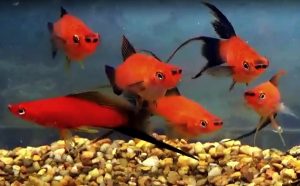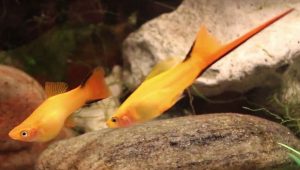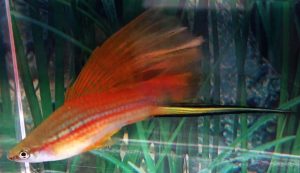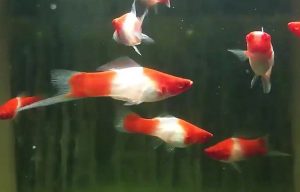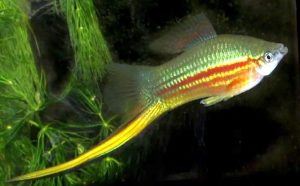The Green Swordtail or Common Swordtail (Xiphophorus helleri) is a hardy, colorful, freshwater/brackish water, live bearing species endemic to southeastern Mexico, southern Belize, central Guatemala, and northwestern Honduras that is related to guppies, mollies, and platys.
The Green Swordtail (Xiphophorus helleri) a.k.a. Common Swordtail is very closely related to Xiphophorus maculatus (the southern Platy) and will readily cross breed with it.
Native to areas of North and Central America, from Veracruz, Mexico to northwestern Honduras, the Green Swordtail has been bred into various hybrid forms for tropical fish keeping enthusiasts in the aquarium hobby and because of it’s hardiness, is commonly used in laboratories including Space Shuttle flights for experimental genetic and research purposes.
In their native habitat, the Green Swordtail prefers densely vegetated, fast flowing rivers and rocky streams, however it has also been collected in warm springs, ditches, ponds, and weedy canals with clear or turbid water. Adults normally congregate in areas with faster moving currents while juveniles seem to prefer the slower moving marginal areas.
Green Swordtails are an omnivorous species that eats insects, annelid worms, small crustaceans, and plant matter. In the wild, male Green Swordtails often grow to a length of 5.5″ and females to a little over 6″ in length.
Male Swordtails posses an elongated lower lobe on their caudal fin, which gives them their namesake. +
Wild specimens are an olive green color with a red or brown lateral stripe that stretches from the snout, through the eye to the tail, and speckles on the dorsal and caudal fins. The sword of the male is yellow, edged below in black.
Female Green Swordtails are considerably larger than the males and lack the lower caudal sword. Green Swordtails have a tendency to undergo sex reversal under certain environmental conditions from female, to male.
Captive breeding of Green Swordtails has produced some beautiful color varieties and pattern variations of red, black, green, yellow, albino, and blue. Because of extensive interbreeding with the southern Platyfish, most captive bred Swordtails sold to tropical fish keeping enthusiasts today are to some degree hybrids.
The most common Swordtail varieties available to tropical fish keeping enthusiasts are the Red Wag, Red Velvet, Marigold, Black Nubian, Pineapple, Tuxedo, Koi, Lyretail, Black, Hi-fin, and Neon Swordtail.
Green Swordtails are well suited for community aquariums, however, male Swordtails will often demonstrate territorial aggression towards other males, so care should be taken when housing more than a single male.
Green Swordtails are best kept in a densely planted aquarium of at least 20 gallon capacity with a dark fine gravel or sandy substrate, plenty of rocks, a small piece of driftwood
or bogwood, and plenty of free swimming space. The are accomplished jumpers so a tightly fitting aquarium cover or a mat of floating plants should be provided to minimize this activity. They need some water movement in their tank which can be provided by a good outside filter and/or a small power head.
Green Swordtails are sexually mature after eight to twelve months and are extremely easy to breed. Females produce anywhere from 20 to over 200 fully formed fry after a gestation period of 24 to 30 days. A spawning box is highly recommended, or you can provide a dense mat of long rooted floating plants like Water Hyacinth to protect the Swordtail fry from potential predation. The fry grow quickly and can be fed crushed omnivore flakes, baby brine shrimp
, Daphnia
, etc. almost immediately. Male swordtail fry should be separated once their sex determined.
Green Swordtails are an omnivorous species that will readily accept live, frozen, or freeze dried tubifex, bloodworms, brine shrimp, algae, and a variety of commercially prepared flaked foods.
The common Green Swordtail (Xiphophorus helleri) is readily available in most tropical fish keeping shops and online from dealers, importers, and breeders in a variety of colors and pattern variations. They are normally sold when they reach an approximate purchase size of 1-1/2″ to 2-1/2″ in length.
Minimum Tank Size: 20 gallons
Care Level: Moderate
Temperament: Peaceful
Hardiness: Hardy
Water Conditions: 65-82°F, dH 10-20, 90-447 ppm, pH 6.0-8.0
Max. Size: 6.3″
Color Form: Assorted, Orange, Red, Yellow, Green, Black
Diet: Omnivore
Compatibility: Peaceful Community Tanks
Origin: North and Central America
Family: Poeciliidae
Lifespan: 5 years
Aquarist Experience Level: Beginner



